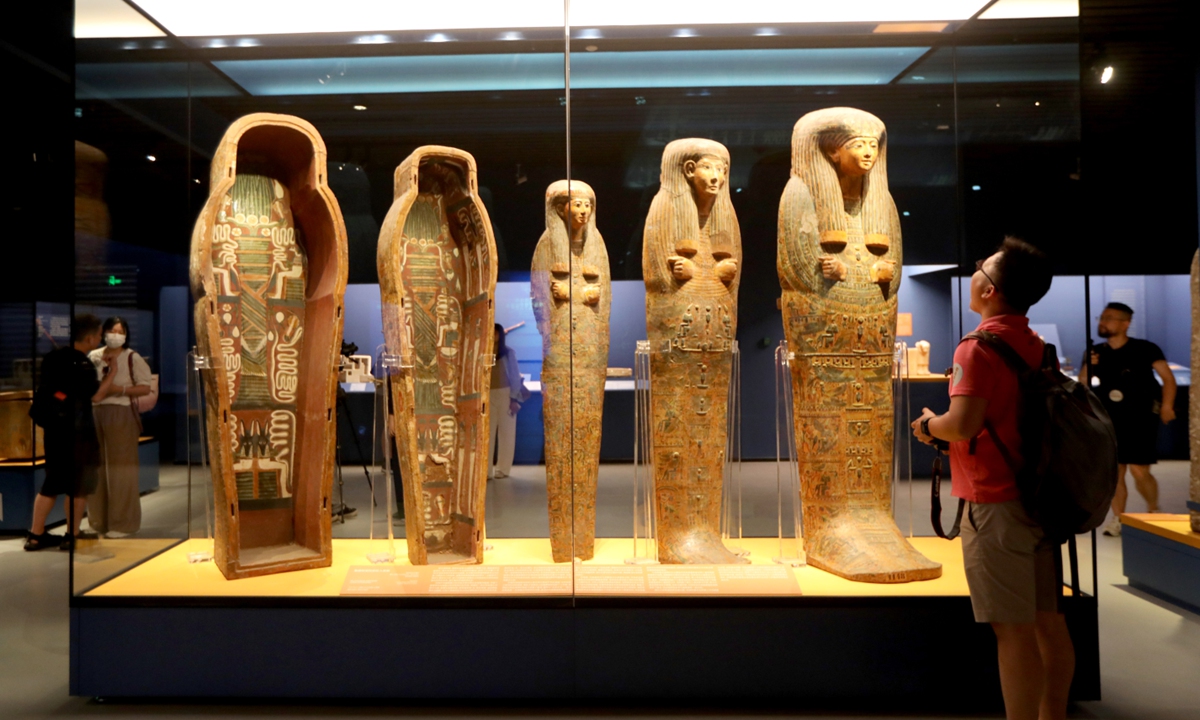
Visitors explore the preview event for the On Top of the Pyramid: The Civilization of Ancient Egypt exhibition at the Shanghai Museum. Photo: Chen Xia/GT
In the warm yellow light, the Bust of King Ramesses II stands silently, a majestic figure frozen in time. Just a few steps away, the painted anthropoid inner coffin of Amennutnakht lies in a glass showcase, its colors still vibrant after millennia.
They, together with hundreds of other ancient Egyptian artifacts on display, weave a tale of a distant, mysterious, and brilliant civilization. In the deep blue-hued exhibition hall in Shanghai, visitors almost feel as if breezes from the Nile River are gently blowing through the exhibition.
The exhibition On Top of the Pyramid: The Civilization of Ancient Egypt will kick off at the Shanghai Museum on Friday, bringing Chinese visitors a feast composed of some 788 artifacts from different periods of ancient Egypt, from statues of pharaohs and anthropoid inner coffins to gold jewelry.
Over 95 percent of the exhibits are being displayed in Asia for the first time, according to the museum.
Co-hosted by the museum and the Egyptian Supreme Council of Antiquities, the anticipated exhibition is the fruit of cooperation between the Chinese and Egyptian governments and museum institutions.
"I feel very excited," Chu Xiaobo, director of the museum, told the Global Times at the exhibition's media preview on Tuesday.
"This is the first time that China and Egypt, the world's oldest civilizations, have had cultural exchanges between the two countries in the form of an exhibition."
Chu mentioned that there has been little official cooperation between China and Egypt in exhibitions before.
"This time we finally realized our dream," he said.
The main part of the exhibition is named "The Land of the Pharaohs," which is "a condensed history of ancient Egyptian civilization," said Chu. Some 500 artifacts are exhibited in this section, creating a journey through 3,000 years that showcases ancient Egypt's cosmology, sacred monarchy, nobility, artisan skills, literati lifestyle, religious beliefs and burial customs.
Many of the exhibits are a window into the establishment of the order and kingship in ancient Egypt, which were also accompanied by the birth of local myths, the exhibition's chief curator Yan Haiying said at Tuesday's preview.
Yan cited a set of statues on display as an example: the Standing Statue of Apries as Osiris, Statue of Isis Suckling Horus, and the Figure of Resurrecting Osiris. Osiris is the embodiment of the dead and resurrected kings, and Isis and Horus are respectively his wife and son. In ancient Egyptian mythology, Osiris rose from the dead twice and became a god.
"The Osiris story was one of the most important myths in ancient Egyptian kingship," Yan explained.
"The ancient Egyptians placed the ultimate expectation - immortality - in it, because it meant that their king could be reborn."
Apart from ancient Egyptian exhibits, this section will also showcase a few ancient Chinese artifacts that wonderfully have a lot in common with the Egyptian relics in terms of shape, design or usage.
Two of the world's four ancient civilizations, ancient Egyptian and Chinese civilizations have many historical similarities, said Chu.
"Therefore, we selected some Chinese exhibits to be part of the exhibition, in the hope that visitors can closely look at the mutual learning between civilizations, through the vivid 'dialogue' between the cultural relics of the two countries," he said.
It is worth mentioning that, apart from looking at the exhibits, visitors can try an VR (virtual reality) expedition named The Horizon of Khufu at the museum to experience ancient Egyptian civilization in a more interesting and immersive way.
"By wearing a VR headset, the 45-minute expedition enables its users to 'walk' through the chambers of the Great Pyramid of Giza, and 'stand' on the top of the pyramid to overlook the entire Giza Plateau," a staffer with the VR project Sun Qingjie told the Global Times.
"For visitors, it will be a brand new experience of exploring ancient Egypt that combines the virtual and reality," he added.
The exhibition is set to run until August 17, 2025.



